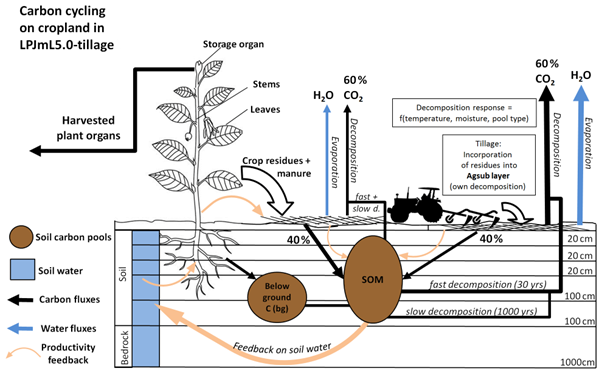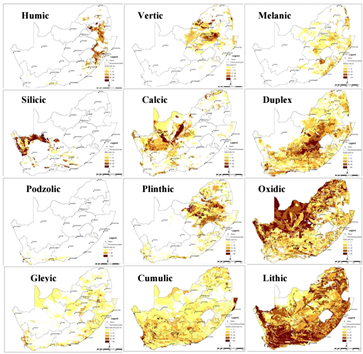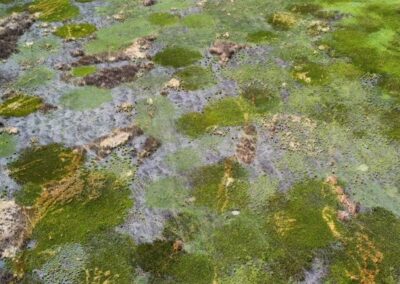By Siviwe Malongweni
The AgriCarbonTM Research team plays a vital role in building CNG’s impact outcomes and programmatic scientific rigour. One of these functions is gathering data to aid the Data and Carbon Development teams to improve their decision-making capacity as to how Improved Agricultural Land Management (IALM) practices such as crop-rotation, reduced fertilizer-use, and minimum tillage influence carbon pools within various agricultural sectors and regions. This requires reviewing empirical agricultural studies that assess the efficiency of regenerative agricultural practices on soil organic carbon sequestration to outline the primary drivers of carbon cycling on cropland and pastures.
Figure 1. A simplified representation of the carbon cycle from agricultural land and carbon returns from crop residues and manure (Herzfeld et al. 2021)
The diagram above shows carbon cycling from agricultural land and productivity feedbacks between plants and the soil. It shows how carbon stored in the plant body returns into the soil during the decomposition of crop residues. The returns are proportional to the size of the plant. For every crop variety that the AgriCarbon team includes in our soil carbon programme the AgriCarbon Research team must build a database of crop residue inputs as root and shoot biomass default factors presented in across the spectrum of agricultural literature.
Another central component of monitoring our farmers impact is that of soil sampling. The AgriCarbon Research team has developed a soil sampling guide following a stratified random sampling approach that involves dividing sampling sites into homogenous sections (in terms of soil type, climate, and land-use types). There is no scientific doubt that South Africa is highly variable in terms of climate and soil (Figure 2 and 3). The country experiences rainfall that varies significantly from west to east. The north-western regions are very dry, with some areas receiving as little as 200 mm of annual rainfall, whereas much of the eastern highveld occasionally receive rainfall exceeding 1400 mm per year.
Figure 2. Koppen-Gieger’s climate classification of South Africa representing different climatic regions across the country (Adesina et al. 2015).
Due to this large contrast between moist and dry regions, the country also has large differences in parent material. A parent material is a mineral rock in which a soil develops through the process of weathering and natural erosion. The Northern region is dominated by some of the oldest geological formations on the planet. We also have very young (newly developed) soils in certain parts of the country. This has led to the classification of 12 broad soil type categories in South Africa (Figure 3) and our strata have been classified according to these different types. Lastly, strata have been classified according to whether ploughing is an essential part of farming activity. Stratifying according to climate, soil land use class create useful classification zones through which our modelling tool can be calibrated.
Figure 3. Distribution of the soil types (groups) across South Africa. The lightest colour indicates between 1 and 7% soil distribution in the mapping unit whilst the darkest colour indicates more than 60% (Fey 2010).
CNG believes that the major benefit of stratified random sampling is that it most accurately reflects the key population characteristics in the sample, while reducing barriers to entry from over-sampling. Through this approach the AgriCarbon team has been able to accurately model soil organic carbon (SOC) stock changes following the adoption of IALM practices which also allows CNG to deliver a highly robust carbon modelling tool with minimized uncertainty.
References:
Adesina J, Kumar K.R. and Sivakumar V. 2015. Aerosol-Cloud-Precipitation Interactions over Major Cities in South Africa: Impact on Regional Environment and Climate Change. Aerosol and Air Quality Research (1):1-17.
Christina M. Botai C.M., Botai J.O., AdeolaI A.M. 2018. Spatial distribution of temporal precipitation contrasts in South Africa. South African Journal of Science, 114:7-8. https://aaqr.org/articles/aaqr-15-03-oa-0185.pdf
Fey M.V. 2010. A short guide to the soils of South Africa, their distribution and correlation with World Reference Base soil groups. World Congress of Soil Science, Soil Solutions for a Changing World, Brisbane, Australia.
Herzfeld T., Heinke J., Rolinski S. & Müller C. 2021. Soil organic carbon dynamics from agricultural management practices under climate change. European Geosciences Unions, 12(4): 1037-1055.






